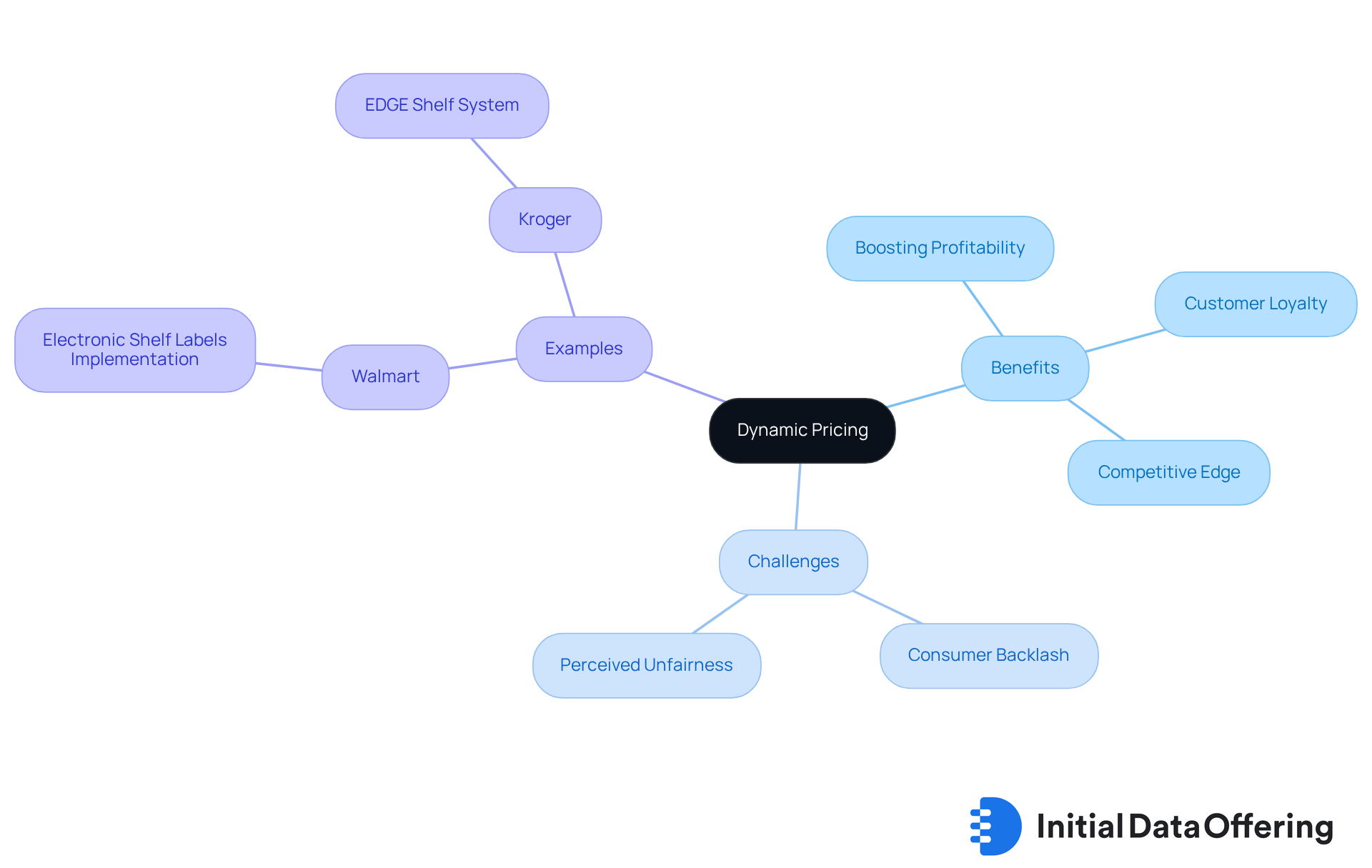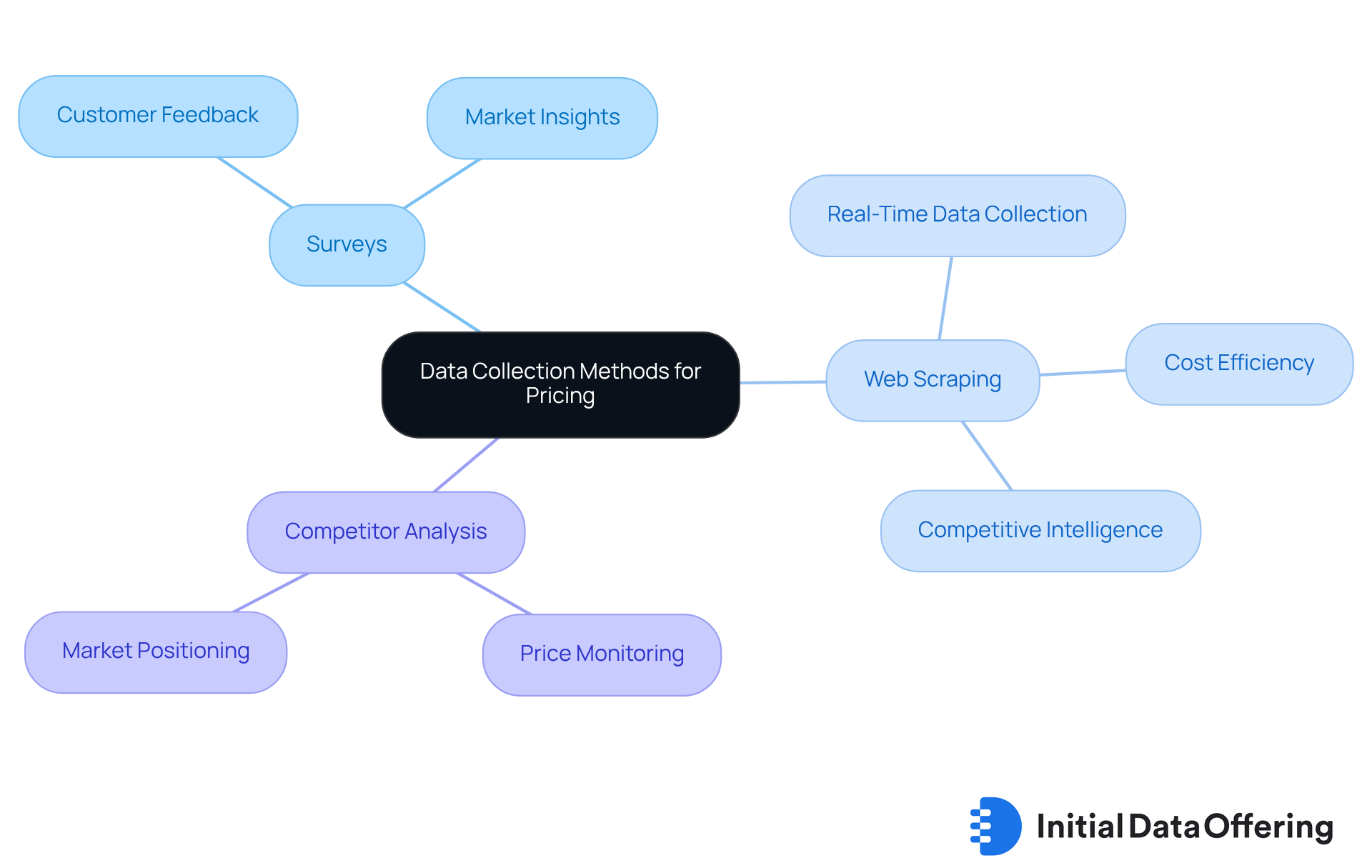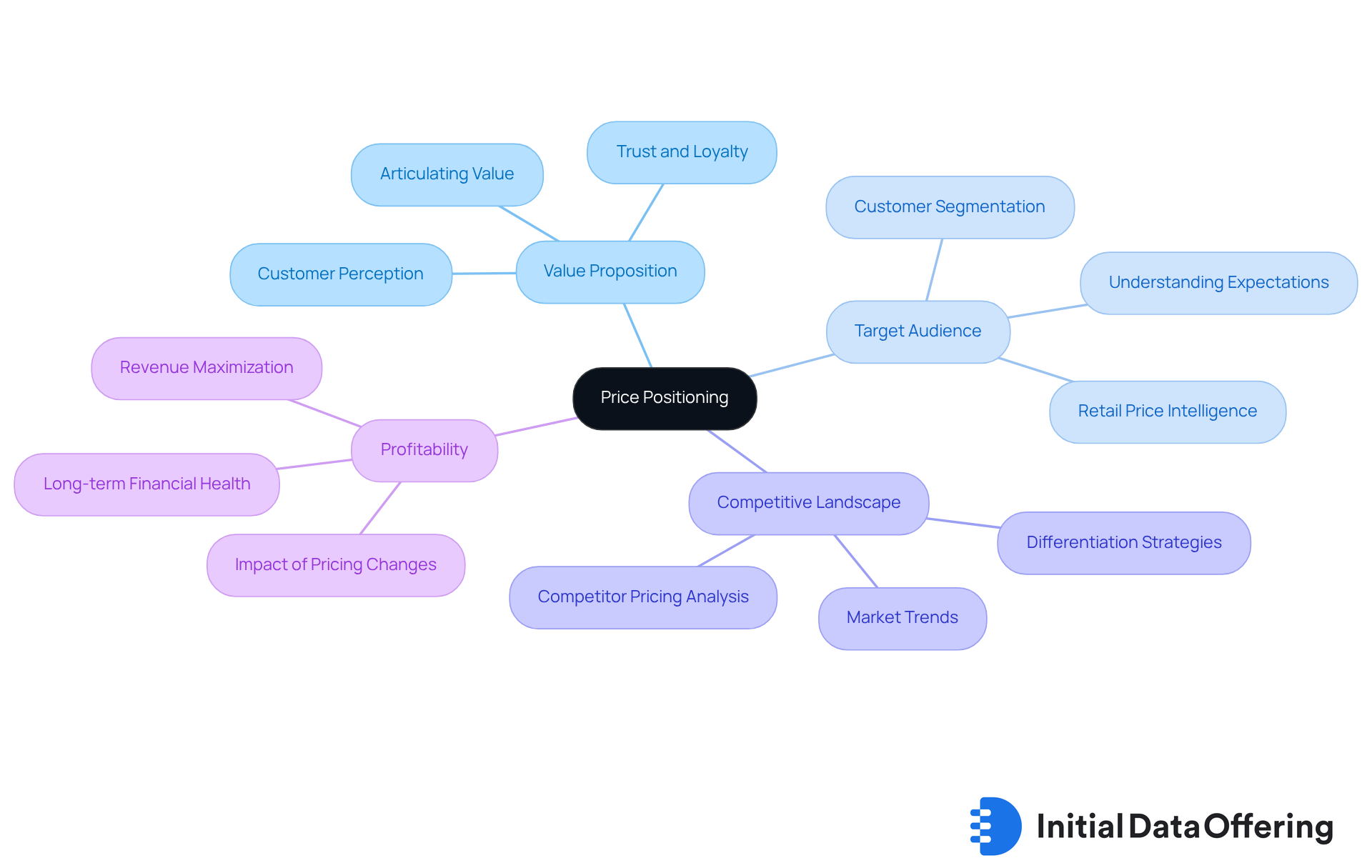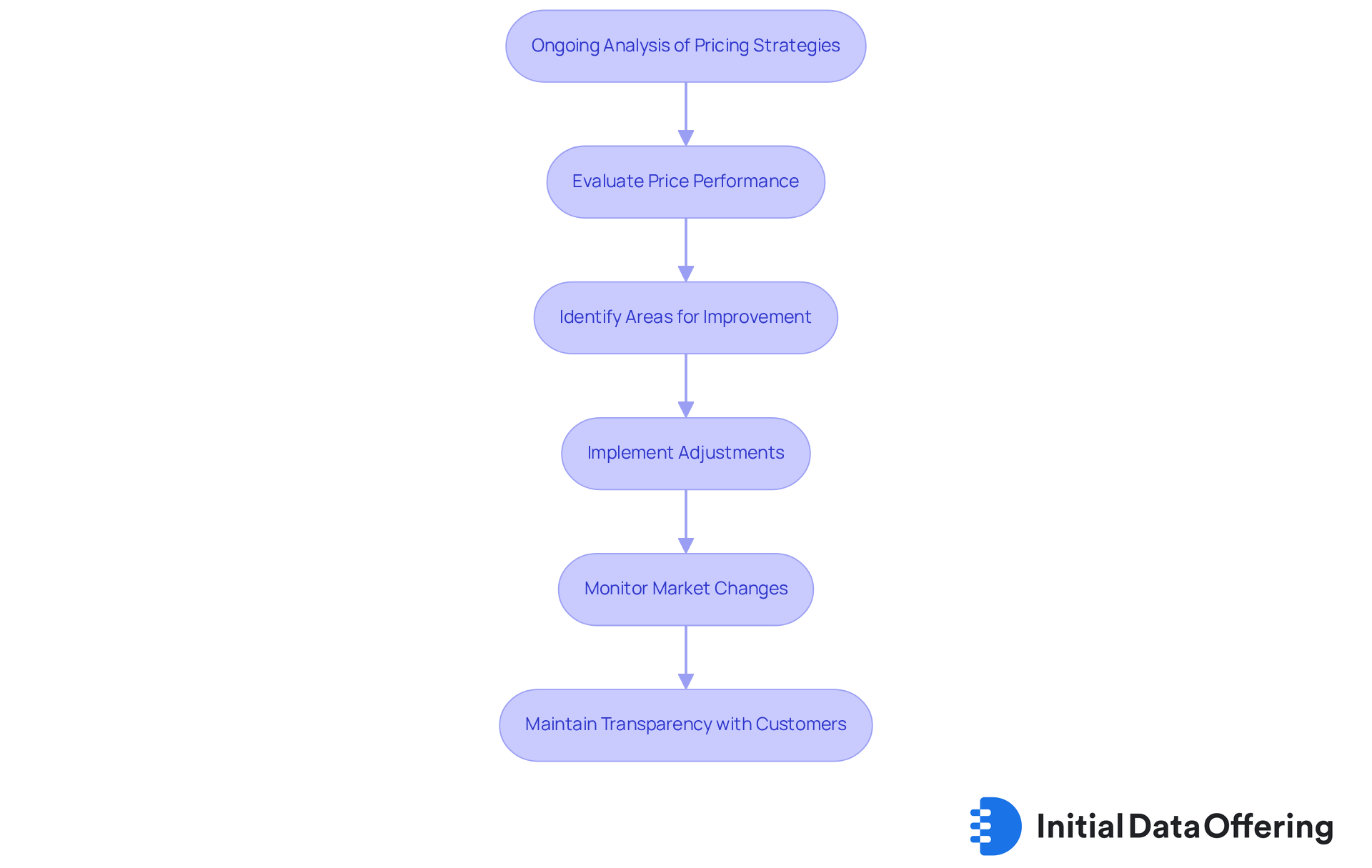10 Essential Strategies for Retail Price Intelligence Success

10 Essential Strategies for Retail Price Intelligence Success
Introduction
In the fast-paced retail environment, understanding pricing strategies is not just beneficial - it's essential for survival. Retail price intelligence provides merchants with a powerful toolkit to navigate market complexities. This toolkit enables them to harness premium datasets, analyze competitors, and implement dynamic pricing models. But with the rapid evolution of consumer behavior and technological advancements, how can retailers effectively adapt their pricing strategies to maximize profitability and customer satisfaction?
This article explores ten essential strategies that can transform retail pricing approaches. By doing so, businesses can not only keep pace but thrive in a competitive landscape. Each strategy will be examined through the lens of its features, advantages, and benefits, ensuring that readers can apply these insights to their own practices.
Initial Data Offering: Access Premium Datasets for Pricing Insights
Initial Data Offering (IDO) serves as a vital asset for merchants aiming to leverage high-quality datasets for informed value assessment. What makes IDO essential? It grants access to unique datasets, including alternative data and ESG data, enabling businesses to analyze market trends and consumer behavior with precision. This capability is crucial for leveraging retail price intelligence to identify optimal cost strategies that not only meet market demands but also strengthen competitive positioning.
As sellers increasingly adopt alternative data, they can leverage retail price intelligence to anticipate shifts in consumer preferences and adjust their pricing strategies accordingly. This proactive approach leads to enhanced profitability and improved customer satisfaction. Consider this: effective execution of these strategies demonstrates that utilizing high-quality datasets can significantly impact cost insights, allowing sellers to navigate market complexities with greater efficiency.
In summary, IDO empowers merchants to make data-driven decisions, ultimately fostering a more responsive and competitive business environment.

Competitive Benchmarking: Analyze Rivals to Optimize Pricing
Competitive benchmarking is a vital process for merchants aiming to enhance their pricing strategies by analyzing the cost tactics of their competitors. This involves a comprehensive examination of various elements, such as cost structures, promotional strategies, and overall market positioning. By understanding how rivals price similar products, sellers can make informed adjustments to their own rates, ensuring they remain competitive in a constantly evolving market.
For instance, retailers can identify significant cost gaps by reviewing customer complaints that competitors are not addressing, which enables them to enhance their offerings. Ongoing benchmarking is essential; as market conditions shift, so too must financial strategies. Retailers should reassess their competitive analysis quarterly or biannually to stay ahead of trends and changes in consumer behavior.
Successful examples abound, such as Tesla's distinctive cost structure, which signals slightly higher quality while undercutting the premium tier, setting it apart from other electric vehicle manufacturers. This illustrates the impact of strategic pricing on market perception. Additionally, companies like Dick's Sporting Goods have effectively utilized diverse content strategies to engage audiences, which supports their pricing methods by boosting brand visibility and customer loyalty.
Current trends indicate that tools utilizing retail price intelligence for dynamic pricing adjustments are gaining importance, enabling sellers to automate changes based on competitor actions. This real-time responsiveness can significantly enhance profitability, as evidenced by merchants experiencing revenue increases of 3-8% through robust retail price intelligence. This underscores the financial benefits of data-driven revenue models.
Market analysts emphasize that successful pricing strategies are grounded in thorough competitor evaluation through retail price intelligence. As industry experts point out, understanding rivals' cost strategies not only informs pricing decisions but also helps sellers identify opportunities for innovation and improvement. By leveraging insights from competitor analysis, retailers can refine their pricing approaches, ultimately driving growth and enhancing customer satisfaction.

AI and Predictive Analytics: Transform Pricing Strategies with Data
Artificial Intelligence (AI) and predictive analytics are fundamentally transforming cost strategies in retail by enabling the rapid analysis of extensive datasets. Retailers leveraging these technologies can use retail price intelligence to accurately forecast market trends, consumer behavior, and price elasticity. This capability empowers them to implement dynamic pricing models that optimize profitability. For instance, companies like IKEA utilize AI-driven forecasting models that consider seasonal events to predict demand across seasons, ensuring optimal inventory levels and minimizing stockouts.
The incorporation of AI enables businesses to swiftly adjust to market fluctuations and consumer preferences, enhancing their competitive advantage. As a result, 73% of merchants are anticipated to implement or test AI to enhance customer experiences by 2025. This statistic highlights the increasing trend of AI adoption in the sector. Moreover, predictive analytics has demonstrated its ability to decrease operational inefficiencies by 40%, simplifying cost decisions and improving overall business performance.
Current trends suggest a notable shift towards the use of retail price intelligence in AI for pricing optimization. By 2025, 95% of businesses are anticipated to utilize AI in supply chain management. This trend underscores the importance for businesses to adopt these technologies to satisfy increasing consumer expectations and enhance profitability. However, it is important to note that only 33% of shoppers feel AI is making their retail experience noticeably better. This indicates a need for businesses to address consumer perceptions and enhance the value of AI applications.
By utilizing AI and predictive analytics, merchants can not only enhance their cost approaches but also cultivate stronger customer loyalty through personalized rates and targeted promotions. How can your business leverage these insights to improve customer experiences and drive profitability?

Dynamic Pricing: Adjust Prices in Real-Time for Maximum Profit
Dynamic cost adjustments allow sellers to leverage retail price intelligence to change their rates instantly, responding to fluctuations in demand, competitor pricing, and inventory levels. This agile approach enables businesses to capitalize on opportunities during peak demand periods while optimizing sales during slower times. Industry leaders emphasize that effective pricing strategies are crucial for maximizing revenue. For instance, Katharine Paine highlights that a mere 1% increase in price can lead to an 11% rise in profits.
Major retailers like Walmart and Kroger are at the forefront of this trend. Walmart plans to implement electronic shelf labels in 2,300 locations by 2026, facilitating quick price adjustments and enhancing operational efficiency. These innovations not only streamline pricing processes but also improve the shopping experience by providing consumers with real-time product information.
While the benefits of dynamic cost adjustments through retail price intelligence are evident - boosting profitability, fostering customer loyalty through perceived fairness, and helping retailers maintain a competitive edge in a volatile market - it's essential to recognize potential challenges. For example, consumer backlash may arise from perceptions of unfair pricing. As the market landscape evolves, companies that effectively leverage these strategies are likely to thrive, turning challenges into opportunities for continuous growth.
How can your business adapt to these dynamic pricing strategies? Consider the implications of real-time adjustments on your operations and customer relationships.

Psychological Pricing: Leverage Consumer Behavior for Better Sales
Psychological strategies serve as a tactical method that aligns costs with consumers' emotions and perceptions, significantly influencing their buying choices. For instance, techniques like charm pricing - where items are priced at $9.99 instead of $10 - create a perception of value that effectively encourages purchases. This method taps into the consumer's subconscious, making the price appear more attractive and affordable.
Recent trends reveal that consumers are increasingly price-aware, with 79% of shoppers actively seeking deals and trading down in their purchases due to rising costs. This shift underscores the importance of pricing strategies that resonate with consumer sentiments. For example, Dollar Tree's transition to multiple price points has elicited varied responses; while it has attracted higher-income shoppers, it has also alienated its longtime clientele who feel excluded. As noted, "Dollar Tree's price increases have led to customer dissatisfaction, with many feeling alienated as the store shifts focus to higher-income shoppers."
Successful examples of charm strategies in retail highlight its effectiveness in driving sales. Retailers that employ psychological sales techniques can utilize retail price intelligence to gain insights into consumer behavior and create offers that connect with their target audience. By recognizing the emotional triggers that influence purchasing choices, sellers can refine their cost approaches to enhance perceived worth, ultimately boosting sales and fostering customer loyalty.
As consumer habits continue to evolve, particularly among younger groups like Gen Z, who prioritize financial stability while being willing to spend on convenience, retailers must adapt their cost strategies accordingly. By 2035, Gen Z is projected to contribute an additional $8.9 trillion to the global economy, emphasizing the importance of understanding this demographic's preferences in pricing approaches. This adaptability will be crucial for maintaining competitiveness in a rapidly changing retail landscape.

Data Collection Methods: Gather Accurate Pricing Information
Collecting precise cost information is crucial for retailers, and it requires a variety of data gathering techniques. These methods for retail price intelligence include:
- Surveys
- Web scraping
- Competitor analysis
By employing these techniques, retailers can leverage retail price intelligence to gather real-time data on market prices, consumer preferences, and competitor strategies.
Advantages: This comprehensive approach ensures that companies have access to the most relevant and up-to-date information.
Ultimately, retail price intelligence provides businesses with accurate data that empowers them to make informed cost decisions and enhance their competitive edge.
How can these data gathering methods be integrated into your current strategy? Consider the potential impact of real-time insights on your pricing and marketing efforts.

Competitor Price Monitoring: Stay Ahead in the Pricing Game
Competitor price monitoring, which is a crucial activity, can be effectively enhanced through retail price intelligence by systematically observing and analyzing the pricing strategies of rivals. This practice helps retailers uncover trends and opportunities in the market. By tracking competitors' price changes, retailers can proactively adjust their own prices, ensuring they stay competitive in a rapidly evolving landscape. This ongoing examination not only enhances financial strategies but also significantly boosts profitability.
For instance, companies that implement data-driven competitive pricing strategies can experience up to a 25% increase in sales volume. Retailers using competitor analysis dashboards can respond to market changes up to 22% faster, allowing them to seize value opportunities swiftly. Successful sellers have demonstrated that integrating real-time competitor pricing data into their strategies can lead to revenue growth of 3-8% and margin improvements of 1-4%. Retailers investing in retail price intelligence often see similar revenue increases, underscoring the importance of robust pricing strategies.
To effectively monitor competitor pricing, sellers should consider utilizing automated price trackers, such as 42Signals. These tools scan thousands of product pages in real-time, providing valuable insights into competitor pricing dynamics and stock levels. This approach enables businesses to determine when to maintain prices or launch targeted promotions, ultimately enhancing their competitive position and driving sales growth.

Price Positioning: Define Your Value Proposition in the Market
Price positioning is crucial for sellers as it directly influences how a product's price conveys its worth in the marketplace. To effectively set prices, retailers must utilize retail price intelligence by analyzing their target audience, competitive landscape, and the perceived value of their offerings. A clearly articulated value proposition, communicated through pricing, not only attracts the right clientele but also differentiates a brand from its competitors.
Experts emphasize that prices should reflect the value consumers perceive in a product. For example, Warren Buffett points out that buyers will only purchase a product if they believe its value exceeds the price. This principle underscores the importance of aligning value strategies with customer expectations to build trust and loyalty. Moreover, consumers are willing to pay slightly more for reliable, high-quality products, highlighting the need for retailers to leverage retail price intelligence to communicate their value effectively.
Successful brands demonstrate the power of articulating their value propositions through pricing. Consider a restaurant that emphasizes high-quality, locally-sourced ingredients; it can justify premium prices, attracting discerning customers who prioritize quality over cost. This strategy not only boosts customer satisfaction but also strengthens the brand's reputation as a provider of exceptional value.
Furthermore, effective pricing strategies informed by retail price intelligence can significantly impact profitability. Research indicates that even a 1% increase in prices can lead to an 11% rise in profits, illustrating the financial benefits of thoughtful pricing decisions. Conversely, poor pricing can result in lost profits and harm branding and reputation. By understanding and communicating their unique value offerings, vendors can refine their pricing strategies to enhance revenue while maintaining a strong market presence. Clear pricing structures foster customer trust and loyalty, reinforcing the connection between pricing strategies and customer satisfaction.

Pricing Intelligence Tools: Streamline Your Pricing Strategy
Cost intelligence tools provide merchants with essential data and insights necessary for making informed financial decisions. These advanced solutions automate price monitoring, analyze competitor costs, and forecast market trends. This enables businesses to respond swiftly to market dynamics, enhancing their operational agility.
Notably, 87% of merchants are utilizing AI in at least one business domain, with 60% planning to increase their investment in AI. This trend underscores the growing reliance on technology for optimizing cost management strategies. By incorporating price analysis software, merchants can refine their cost strategies, boost operational efficiency, and strengthen their competitive advantage.
Successful implementations have shown that retailers using AI for price management can achieve a 12% increase in sales while reducing unsold inventory by 20%. This statistic highlights the effectiveness of AI in optimizing cost strategies, as noted in various external sources. Furthermore, ethical costs and transparency are crucial, as Indra Nooyi emphasized that clear costs foster customer trust and loyalty.
However, merchants must navigate challenges such as data security and privacy concerns, which pose significant barriers to AI adoption. Overall, retail price intelligence tools not only refine cost methods but also enhance overall retail strategies, enabling companies to adapt effectively to consumer behavior and market changes.
How can your business leverage these insights to improve its pricing strategies? Consider the potential impact of AI on your operations.

Ongoing Analysis: Continuously Adjust Pricing for Market Changes
Ongoing examination of cost strategies is essential for sellers aiming to adapt to market changes and shifts in consumer behavior. By consistently using retail price intelligence to evaluate price performance against current market conditions, businesses can pinpoint areas needing improvement and implement timely adjustments. This proactive approach not only keeps businesses competitive but also enables them to respond effectively to evolving market dynamics.
For instance, sellers who have embraced flexible cost methods have reported revenue increases of 5-20%. Research from Phillips and Chang and Bitran and Caldentey supports this, illustrating the effectiveness of agile adjustments in a fluctuating environment. Successful sellers leverage real-time information and technologies, including retail price intelligence, AI-driven automation, and geolocation-based cost management software, to adjust rates based on demand and competitor behavior. This ensures alignment with consumer expectations.
As insights from market analysts suggest, adapting pricing strategies in response to market changes is not just advantageous; it is crucial for long-term profitability and brand loyalty. How can your business benefit from these insights? By maintaining transparency with customers regarding price adjustments and providing clear reasons for these changes, retailers can build trust and enhance their brand perception. This ultimately drives sustained growth in a competitive landscape.

Conclusion
Retail price intelligence stands as a vital element for businesses aiming to refine their pricing strategies in a competitive market. By leveraging premium datasets, implementing competitive benchmarking, and utilizing AI-driven analytics, retailers can make informed decisions that not only enhance profitability but also boost customer satisfaction. These strategies empower merchants to respond effectively to market dynamics, navigating complexities with both agility and precision.
Key insights discussed throughout the article underscore the importance of psychological pricing, the advantages of dynamic pricing adjustments, and the necessity of ongoing analysis to adapt to consumer behavior. The integration of advanced pricing intelligence tools streamlines these processes, enabling retailers to gather accurate data and implement real-time adjustments that align with market conditions. Each strategy contributes to a comprehensive pricing framework that promotes growth and fosters customer loyalty.
In conclusion, the significance of retail price intelligence is paramount. As the retail landscape evolves, businesses must proactively refine their pricing strategies to meet shifting consumer expectations. By embracing these essential strategies, retailers not only enhance their competitive edge but also cultivate lasting relationships with their customers. Now is the time to assess and implement these insights. Are your pricing decisions reactive, or are they strategically aligned with market trends and consumer needs?
Frequently Asked Questions
What is the Initial Data Offering (IDO) and why is it important for merchants?
The Initial Data Offering (IDO) provides merchants with access to high-quality datasets, including alternative and ESG data, which are essential for analyzing market trends and consumer behavior. This access enables businesses to make informed value assessments and develop optimal cost strategies, enhancing their competitive positioning.
How does alternative data impact pricing strategies for sellers?
Sellers can leverage alternative data to anticipate shifts in consumer preferences, allowing them to adjust their pricing strategies proactively. This approach leads to enhanced profitability and improved customer satisfaction by ensuring that pricing aligns with market demands.
What is competitive benchmarking and how does it benefit merchants?
Competitive benchmarking involves analyzing the cost strategies and promotional tactics of competitors to enhance pricing strategies. By understanding how rivals price similar products, merchants can make informed adjustments to their rates, helping them remain competitive in a changing market.
How often should retailers reassess their competitive analysis?
Retailers should reassess their competitive analysis quarterly or biannually to stay ahead of trends and changes in consumer behavior.
Can you provide an example of effective pricing strategies in retail?
Tesla exemplifies effective pricing strategies with its distinctive cost structure that signals higher quality while remaining competitive against premium tiers. Similarly, Dick's Sporting Goods has utilized diverse content strategies to engage audiences, supporting their pricing methods and enhancing brand visibility.
What role does AI and predictive analytics play in pricing strategies?
AI and predictive analytics enable retailers to analyze extensive datasets quickly, allowing them to forecast market trends and consumer behavior accurately. This capability supports the implementation of dynamic pricing models that optimize profitability.
What is the anticipated trend of AI adoption in retail by 2025?
By 2025, it is expected that 73% of merchants will implement or test AI to enhance customer experiences, and 95% of businesses are anticipated to utilize AI in supply chain management.
What are the benefits of using AI and predictive analytics for merchants?
The use of AI and predictive analytics can decrease operational inefficiencies by 40%, simplify cost decisions, enhance customer loyalty through personalized rates and targeted promotions, and ultimately improve overall business performance.
What is the current consumer perception of AI in retail?
Only 33% of shoppers feel that AI is making their retail experience noticeably better, indicating a need for businesses to address consumer perceptions and enhance the value of AI applications.